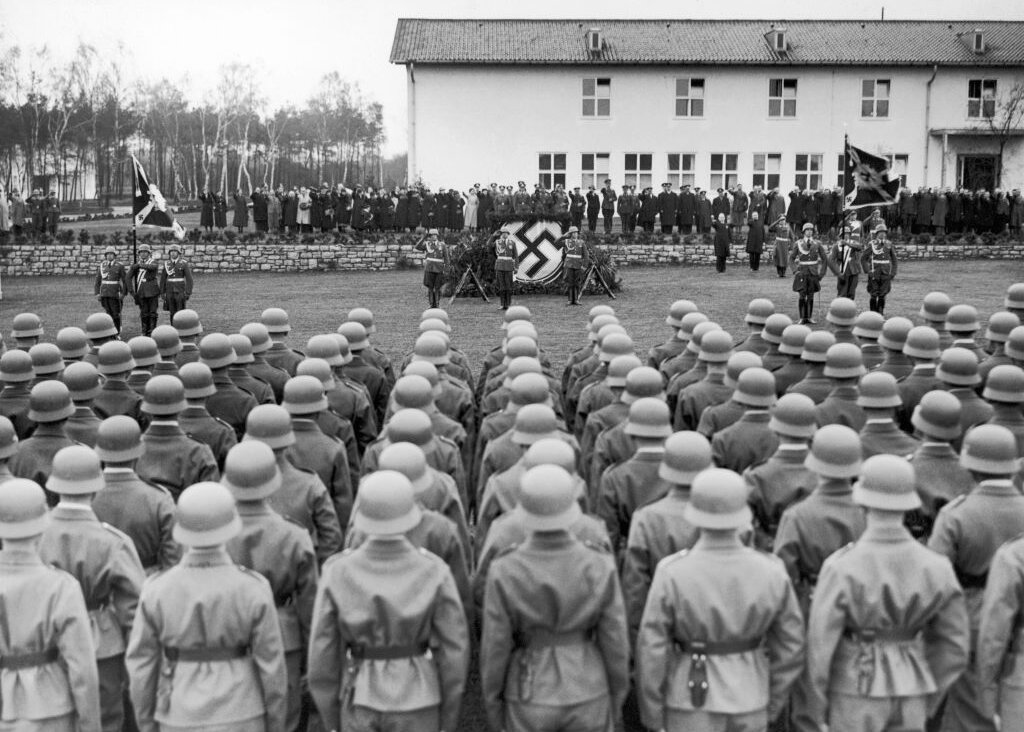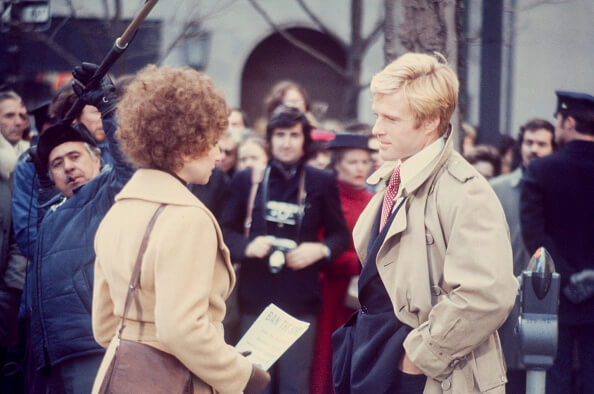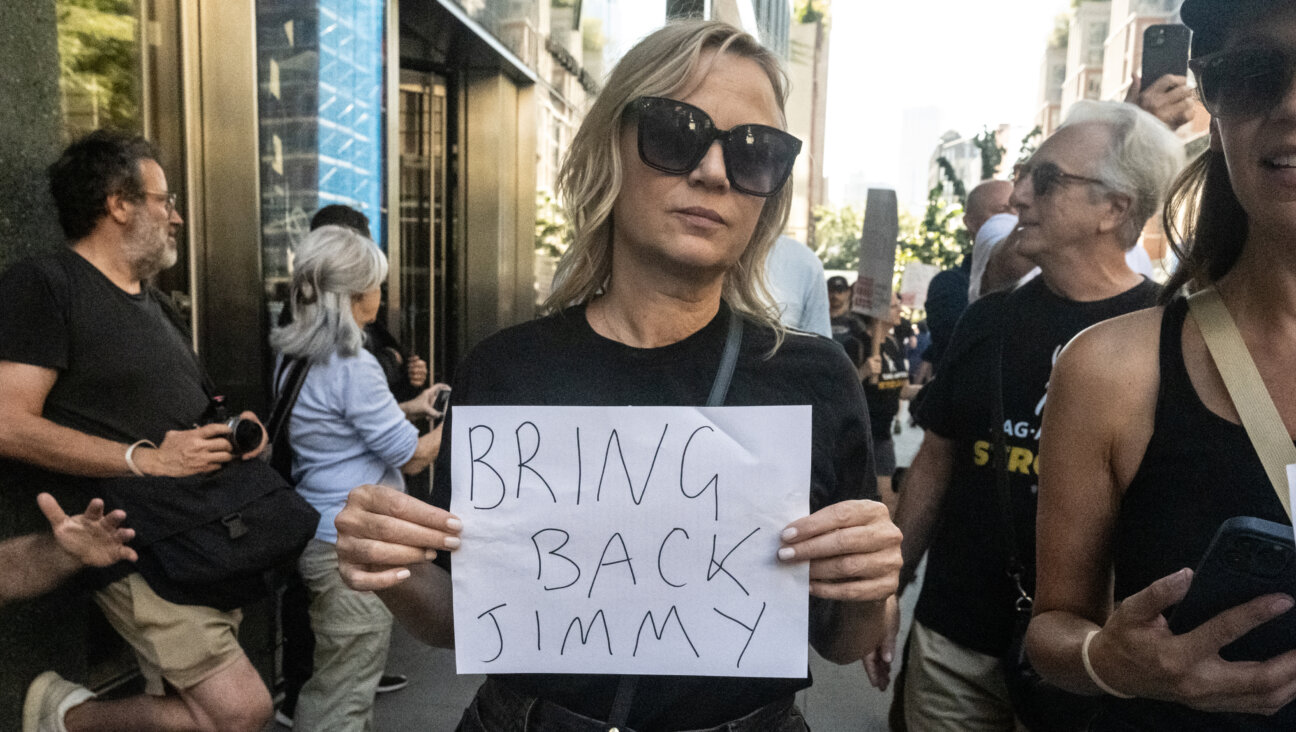Spike Lee’s Wild, Wonderful World Of Jews

Spike Lee and the cast of “Do The Right Thing” Image by Getty Images
Sign up for Forwarding the News, our essential morning briefing with trusted, nonpartisan news and analysis, curated by Senior Writer Benyamin Cohen.
“It’s cheap, I got a good price for you, Mayor Koch, ‘How I’m doing,’ chocolate-egg-cream-drinking, bagel and lox, B’nai B’rith asshole!”
Not bad … but what about “neurotic,” “dreidel-spinning,” “self-hating,” and all the rest?
Then again, the Korean grocer who hurls anti-Semitic slurs at the camera midway through Spike Lee’s “Do The Right Thing,” which turns thirty this month, probably hasn’t met more than a dozen Jews in his entire life. His stereotypes seem to be based on Ed Koch TV spots and arguments with the occasional rude customer. As if to emphasize this point, the Jew-bashing part of the “racial slur montage,” maybe the greatest scene in maybe the greatest American film of the 1980s, is the only one that isn’t clearly targeted at another character. In this quintessential slice of New York life, which features blacks, Italians, Puerto Ricans and Koreans, there are Jewish slurs but no Jews.
“There is not a filmmaker in America working today,” Lee wrote in 1990, “whose films are scrutinized like mine. Film critics, journalists, social scientists, politicians pore over every single word, every single image, every single frame.” It’s a classic Lee humblebrag, more of an invitation than a complaint. His films aren’t exactly famous for their subtlety, but they hold up to scrutiny remarkably well — one important reason why so many of them are worth watching again and again. Few parts of the Lee oeuvre are as subtle and scrutiny-rewarding as his depictions of Jews. On the evidence of his 24 features, it’s impossible to confront the struggles and ironies of race in America without confronting the Jewish-American experience. These movies abound with Jewish characters, and even when there are none onscreen, other characters are plainly, deeply aware of Jewishness — it is admired, envied, resented, coveted.
Is this surprising? From the outset of his career, Lee was a brash media figure with a knack for getting the critics talking, and even today some of the same critics continue to assume that his films are as bluntly simplistic as his interviews. Lee’s public statements about Jews have never been mistaken for subtle. In the mid-80s some (bizarrely) regarded Lee as a black Woody Allen, a comparison which Lee (naturally) rejected. Then came his decade-long beef with Steven Spielberg, beginning when Warner Bros. announced that Spielberg would direct “The Color Purple.” Then, the accusations of anti-Semitism that greeted “Mo’ Better Blues” (prompting the op-ed quoted above). Then, his offensive, stupid, and (most important) just plain inaccurate rebuttal: that “Mo’ Better Blues” couldn’t have been anti-Semitic, since Jews run Hollywood, “and that’s a fact.”
Still, trust the tale and not the teller. Searching for Jews in Lee’s films, you’ll find a wider range of types and temperaments: the racial slurs montage from “Do The Right Thing,” as well as the updated version from “25th Hour,” with its Hasidim hocking South African diamonds, but also the European Jews cheated by Christopher Plummer’s wicked banker in “Inside Man.” There’s Billy the Jew, one of several scapegoats bullied by the loser vigilantes in “Summer of Sam,” and then there’s Rick, the driver from “Get On The Bus” who refuses to transport a group of black men to the Million Man March because Louis Farrakhan said Hitler was a great man. There are the two treacherous nightclub owners played by John and Nicholas Turturro in Mo’ Better Blues,” and Flip Zimmerman, the cop played by Adam Driver in “BlacKkKlansman,” who grew up feeling like “just another white kid” but who realizes he has “skin in the game” when it comes to busting white supremacists.
In various Spike Lee Joints, Jews have been scapegoats, turncoats, victims, allies, bystanders, exploiters, and friends — a decent chunk of the family of man. One thing they’ve never been is Judaic, in the sense of overtly religious. In this, Lee simply resembles the vast majority of Jewish and non-Jewish American filmmakers, a fact which makes his claims about Jews controlling Hollywood seem even more risible. (Except for “A Serious Man,” what mainstream movies about Judaism has Hollywood green-lit in the last ten years? Some control.) Nor do the Jews in Lee’s films boast much in the way of a unique culture — certainly nothing like the rich heritage of music, food, fashion and humor relished by black and Italian characters.
Instead, Lee’s Jews derive their cultural identity from the degree to which they’ve been assimilated into white American culture. They are, at different times, minority and majority, exploiters and exploited. That this is an incomplete view should go without saying, but that doesn’t mean it’s not a valuable way of talking about Jewishness (and it seems naïve to expect Lee’s portrayal of the Jewish community to be “complete”). What goes for Flip in “BlacKkKlansman” or Rick in “Get On The Bus” could be said for contemporary American Jews collectively: With the sting of oppression not quite behind them, and numb assimilation dangling ahead of them, they’re pressured into uncomfortable choices. Do they accept white assimilation or battle white supremacy? Do they protect their own interests or extend a hand to those in direr need? Whose side, in short, are they really on?
It’s the same question Lee forces on all his most fascinating characters, from Mookie in “Do The Right Thing” to Flipper Purify in “Jungle Fever” to Pierre Delacroix in “Bamboozled.” This question is, you could say, the burden of social consciousness: everyone’s loyalties are divided, the difference is that some people are smart enough to realize the truth and some aren’t. The only characters in “BlacKkKlansmen” fully secure in their identities are the Klansmen, and then only because they’re too arrogant to realize how flimsy their idea of whiteness really is. For Ron Stallworth, the black detective who infiltrates the Klan, and Flip, his sometimes-reluctant partner, dividedness is the way of the world — in Flip’s case, because he’s a Jew infiltrating white supremacists; in Ron’s, because he’s a cop infiltrating black nationalists as well as a black man working alongside flippant racists. If Ron starts off more aware of his own double consciousness than Flip, the two men end up on much the same page: when it comes to battling white supremacy, they both have skin in the game.
It would be easy, considering that we end up admiring for Adam Driver’s character in “BlacKkKlansman,” to say that Spike Lee’s portrayals of Jews have gotten sunnier. As a headline from the Jewish Telegraphic Agency put it, “Spike Lee’s Jewish characters have gotten better” — the implication being, I suppose, that recently Lee has “come around” on the Jews. This misses the point by a country mile — none of the Jews in his films represent his last word on Jewishness, any more than one of his black characters represents his last word on blackness. The truth is that, by and large, his Jewish characters wind up looking out for themselves and a small group of friends who they perceive to be like them. They are, in other words, exactly like most people in Lee’s films. And most people.
Out of all the accusations that have been made of Spike Lee Joints, one of the most frustrating is that they lack a Point. Critics who’ve been trained to tolerate nuanced, ambiguous work from other directors insist on distilling Lee down into a message, which they inevitably disagree with. Never mind that “Do The Right Thing” was carefully, almost mathematically designed to confound glib interpretations of any kind — no, clearly, the film supports rioting, which makes Spike Lee pro-riot. The fact that so many of Lee’s movies have been greeted with this kind of pedantry surely says a lot about the limits placed on black filmmakers, but it says almost as much about the limits placed on political film more generally. To be political is to be prescriptive; to be nuanced is to be apolitical.
Though every one of Spike Lee’s films (even his “Old Boy” remake) is overtly political, they refuse to do the viewers’ thinking for them. They’re full of political ideas, usually expressed in long monologues or intense back-and-forths, but these ideas rarely converge into solutions — there are too many fractured loyalties, too many sides, too much skin in the game. It makes more sense to think of Lee’s films as arrangements — of ideas and feelings, most of them pretty ugly, about race, class, sex, money, music. In his films, different kinds of people can get along, but under enough pressure, differing ideas and feelings often make cooperation impossible.
This is certainly the case in “Do The Right Thing,” a film that teems not simply with racism but with racial envy, racial self-hatred, racial confusion. I’ve seen the film at least half a dozen times, but it wasn’t until my most recent viewing that I thought about its (non) portrayal of Jews — and the more I thought about it, the more appropriate, and appropriately inappropriate, it seemed. The issue isn’t simply that Bedford Stuyvesant, where the film is set, had few Jewish residents in 1989. (That Lee isn’t making a strictly “accurate” film should be clear even before the opening credits are finished.) In point of fact, Bed Stuy was heavily Jewish for the first half of the 20th century, and Jews’ influence there continued long after the neighborhood had become mostly black. Businesses and apartment buildings remained in large part Jewish-owned. Synagogues, reworked into churches, kept a few stars and mezuzahs (Shaari Zedek on 767 Putnam Ave, e.g., has been St. Leonard’s since 1944).
Jewishness was resented and envied in Bed Stuy, even where there were no Jews. Especially where there were no Jews, perhaps — in anti-Semite folklore, the Jew almost never works his mischief in broad daylight; instead, he’s a master puppeteer, an Elder following the protocol. The garbled insults of the Korean grocer in Bed Stuy betray the muddled logic of so much Jew-hating — lashing out at an enemy who’s never actually seen, possibly because he’s higher up the ladder.
“If one blames the Jew for having become a white American,” James Baldwin wrote in 1967, “one may perfectly well, if one is black, be speaking out of nothing more than envy.” Add “Korean, white working class, Muslim, or Latinx” after “black,” and you have a fair summary of anti-Semitism at its most self-destructive. Hating American Jews isn’t primarily about scapegoating, Baldwin recognized. It’s about secretly wanting the assimilation many Jews have achieved and hating yourself for wanting it — hating as an alibi for wanting.
We see this again and again in Lee’s films, even in brief flashes. For instance — “You’re a rich Jewish kid from the Upper East Side who’s ashamed of his wealth. You walk around unhappy — trying to make up for the fact that you were born privileged. Fuck that. You know what? That’s just some knee-jerk liberalism bullshit, man. You call that reality?” The movie is “25th Hour,” the speaker is Frank, played by Barry Pepper, and the “you” is his sort-of friend Jacob Elinsky, played by the late Philip Seymour Hoffman. As in many a Spike Lee Joint, the speech says at least as much about the accuser as the accused, at least as much about the bully as the Jew. What irritates Frank isn’t simply that Jacob is wealthy (all kinds of people are wealthy), it’s that Jacob doesn’t value what he has: money and privilege that most people, ambitious, hotshot Frank included, would kill for. Mainstream Jewish liberalism and soft anti-Semitism — they can both be bullshit.
Baldwin again: “A genuinely candid confrontation between American Negroes and American Jews would certainly prove of inestimable value. But the aspirations of the country are wretchedly middle-class and the middle class can never afford candor.” In an era when the country’s tastes are as wretchedly middle-class as its aspirations, Spike Lee is an outlier — one of the few artists who stages genuine confrontation, who risks offensiveness to speak about anti-Semite and Jew honestly. In 1990, hot off of “Do The Right Thing,” he released “Mo’ Better Blues,” which addresses — among many other things — the sad history of Jewish businessmen who took advantage of talented, naïve black musicians.
The Anti-Defamation League accused Lee of trafficking in anti-Semitic stereotypes. In the New York Times, James Caryn argued that the film’s two villainous Jewish characters, who take up less than ten minutes of screen time, “become tokens of an entire ethnic group,” since there are no good Jews to balance them out. It was the kind of well-intentioned, clueless backlash that would take the fire out of most filmmakers’ bellies — consider, for instance, the frenzy of controversy that greeted Kathryn Bigelow’s “Zero Dark Thirty,” and then the clumsy, controversy-proof hedging of her follow-up, “Detroit,” with its nice cops and white thieves. You call that reality? Thankfully, Lee ignored his critics and got back to work. If you’re making tough, incisive films about race in America and you’re not pissing people off, you’re doing something wrong.
Jackson Arn is a 2019 winner of a first-place Rockower Award for arts and criticism from the American Jewish Press Association for his Forward article about the artist Martha Rosler.
















